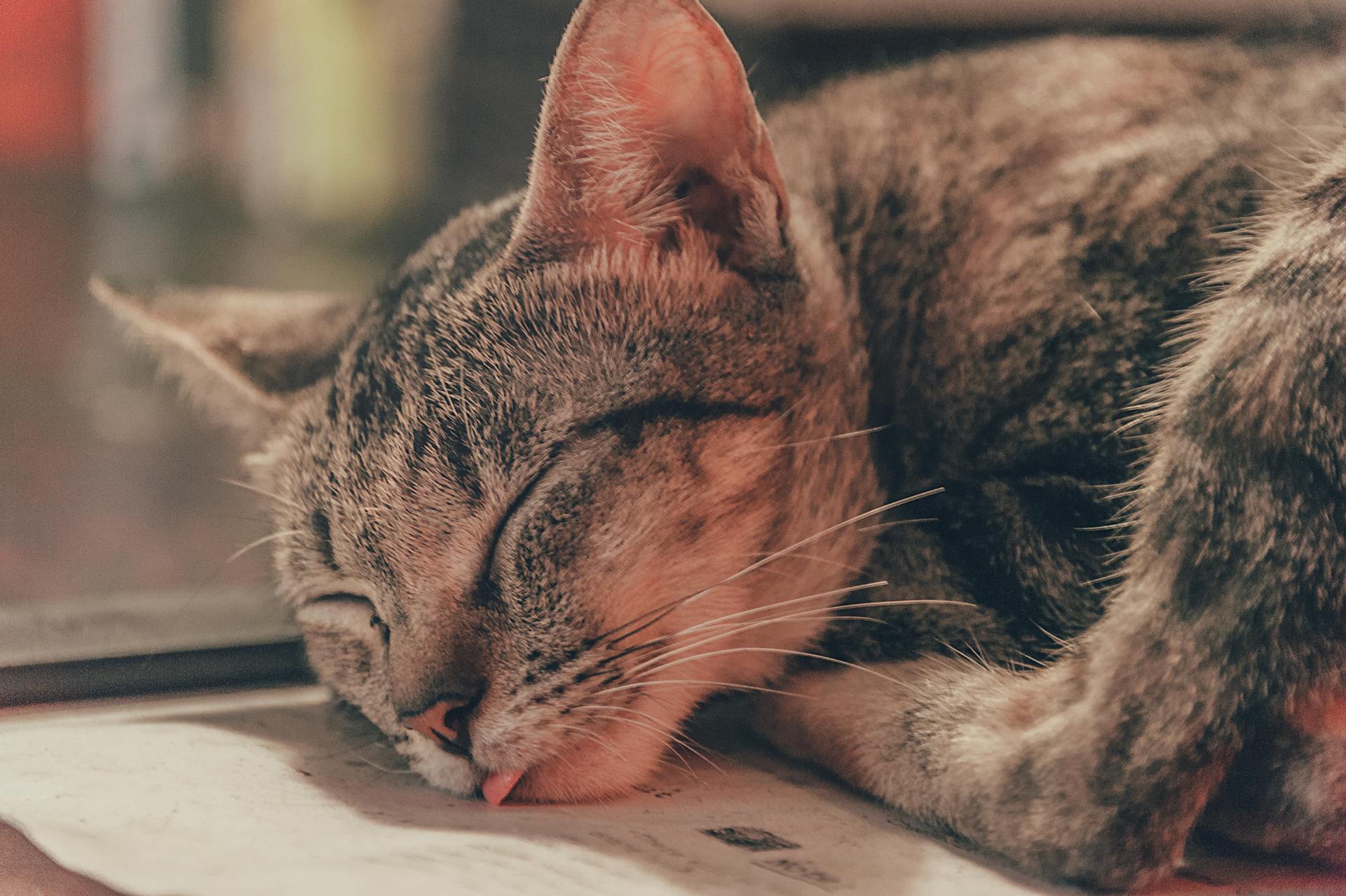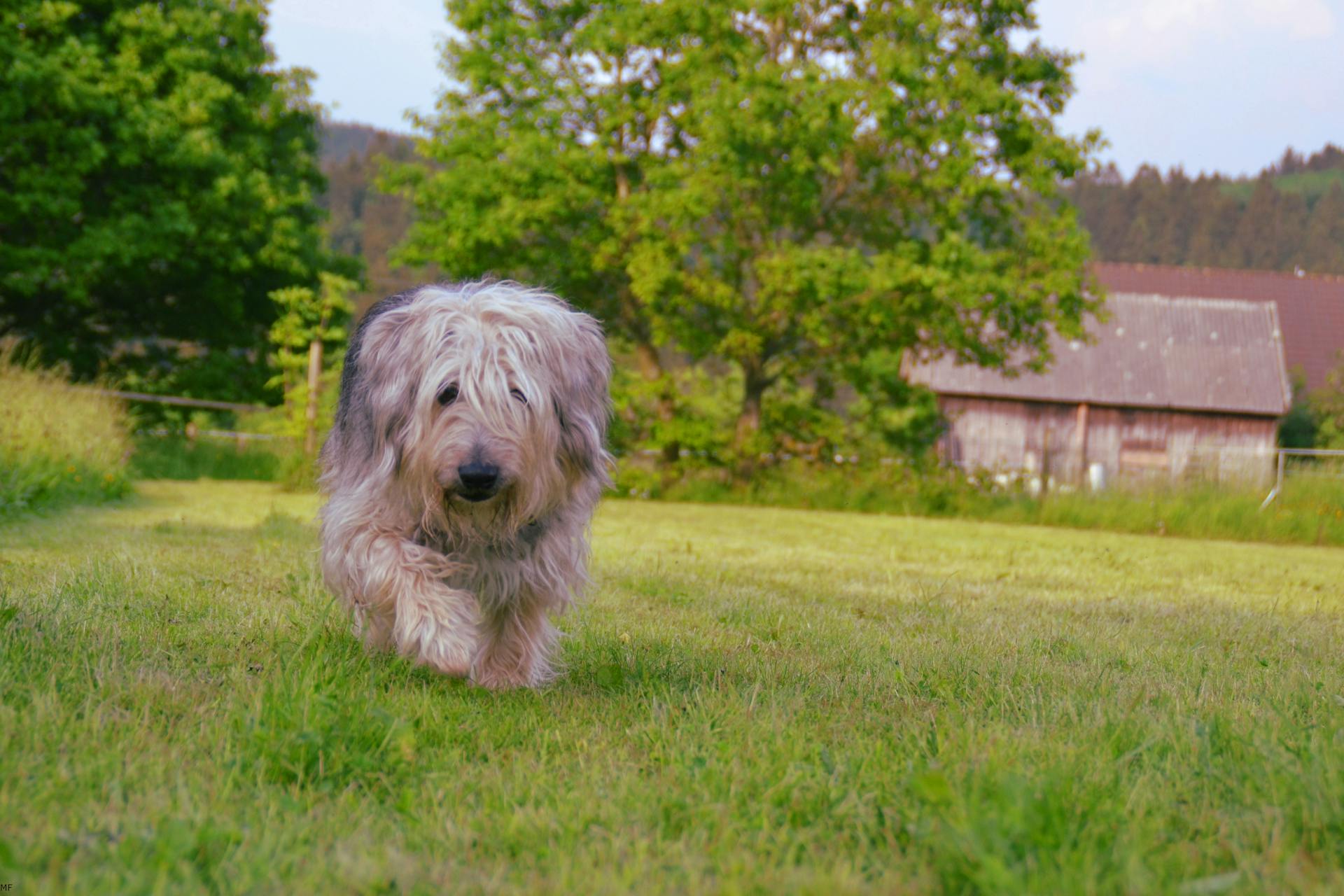
Raising a well-mannered dog is a lifelong process that requires patience, consistency, and positive reinforcement. A well-trained dog is not only easier to live with, but also a joy to be around.
According to our training methods, dogs learn best through repetition and consistency. This means setting clear rules and boundaries, and consistently enforcing them.
A well-mannered dog is more likely to listen to commands and behave in public. This is because they have learned to associate good behavior with rewards and praise.
With the right training and socialization, any dog can become a polite and well-mannered companion.
Readers also liked: Mannered Mutts Dog Training
Positive Training Methods
Positive reinforcement is a magical tool in the world of dog training. It's a way to encourage good behavior by showering your pup with praise, treats, or affection.
The key is to associate positive outcomes with desired actions, like keeping all four paws on the ground. This will encourage your pup to repeat the behavior that earns them these delightful rewards.
Praise, treats, or affection can be used to reinforce good behavior. It's essential to be consistent and timely with your rewards to avoid confusing your pup.
Positive reinforcement is a powerful tool that can help you achieve polite paws. By using it correctly, you can encourage your pup to behave in a way that's respectful and considerate of others.
Basic Commands and Etiquette
Basic commands like "sit" and "stay" can be invaluable in curbing jumping behavior. Incorporate these commands during greetings and reward compliance.
Teaching your dog to associate these commands with calm and composed greetings takes time, but it's worth it. With consistent practice, your dog will learn to respond to these commands.
Practice makes perfect when it comes to training your dog. Regular training sessions specifically focused on greeting behavior will help your dog learn to compose themselves during greetings.
To make practice sessions more effective, enlist the help of friends and family to play the role of visitors. Reward your dog generously when they maintain composure during greetings.
Readers also liked: Reward Based Dog Training
Redirecting your dog's energy from jumping to a more acceptable behavior is a great way to teach polite greetings. Teach your dog to sit or offer a paw when meeting someone, and reward them for making the right choices.
Some alternative behaviors you can teach your dog include fetching a toy or going to their bed when the doorbell or knocking sound is heard. This will help them learn that these actions are incompatible with jumping.
Here are some techniques to help your dog learn polite greetings:
Dog Behavior and Management
Dog behavior is often a result of attention, whether it's positive or negative. Withholding attention when your pup jumps can help them learn to calm down. Stay indifferent until they have all paws on the ground.
Exercise is a crucial aspect of dog behavior management. Physical activity relieves stress and anxiety, burns excess energy, reduces chronic disease risk, and can significantly improve your dog's behavior. I've seen many dogs transform after regular exercise sessions.
To manage your dog's conduct, consider the following strategies:
- Exercise your dog regularly to relieve stress and anxiety.
- Engage your dog's mind with brain games, such as puzzle toys, treat-dispensing toys, and snuffle mats.
- Maintain a consistent daily routine to help your dog feel calm and secure.
- Use confinement, such as crates, pens, and pet gates, to limit your dog's access to certain areas or hazards.
Consistency is key in dog training. A consistent daily routine can help prevent training setbacks and keep your dog calm and secure.
Patience and Understanding
Teaching your dog not to jump is a process that requires patience and understanding. Dogs, much like humans, may take some time to grasp new concepts.
Celebrate small victories and stay patient through setbacks. Consistent, positive reinforcement will eventually lead to a well-mannered, polite pup.
Remember, jumping is just a small hiccup in the wonderful journey of companionship with our dogs. By approaching the issue with love, consistency, and positive reinforcement, you’ll be well on your way to fostering a well-behaved furry friend.
Here are some key takeaways to keep in mind:
- Be patient and celebrate small victories.
- Stay consistent with positive reinforcement.
- Approach the issue with love and understanding.
By embracing patience and understanding, you can help your dog become a well-behaved and polite companion.
Dog Behavior Management
Dog behavior management is crucial for maintaining a peaceful and harmonious relationship with your furry friend. Dogs thrive on attention, whether it's positive or negative, so it's essential to ignore unwanted behavior and focus on rewarding good behavior.
For your interest: It's Your Choice Dog Training
Withholding attention is a simple yet effective way to stop unwanted behavior like jumping. By turning away and avoiding eye contact, you can help your dog calm down and focus on the present moment. This technique works wonders when combined with physical exercise, which relieves stress and anxiety, burns excess energy, and reduces chronic disease risk.
Exercise is a vital component of dog behavior management, and it's not just about physical activity. Mental engagement is also crucial, and brain games like puzzle toys, treat-dispensing toys, and snuffle mats can satisfy your dog's instinctive behaviors and promote calmness.
A consistent daily routine is also essential for maintaining calm and secure behavior in your dog. By scheduling regular activities, like walks and playtime, you can avoid training setbacks and create a sense of predictability for your furry friend.
Here are some dog behavior management strategies to consider:
- Exercise: 30 minutes of physical activity per day to relieve stress and anxiety
- Mental engagement: 15 minutes of brain games per day to satisfy instinctive behaviors
- Schedule: maintain a consistent daily routine to avoid training setbacks
- Confinement: use crates, pens, and pet gates to limit access to certain areas or hazards
By incorporating these strategies into your daily routine, you can help manage your dog's behavior and create a more peaceful and harmonious home environment.
Description
Our Puppy Kindergarten class is designed to help your puppy become a confident and social adult dog through obedience training and socialization. Puppies will learn to remain calm under distraction and not bark at new things.
One of the key skills your puppy will learn is to respond to their name, a crucial part of building trust and communication. They'll also learn polite greetings, which is essential for interacting with people and other dogs.
In our Puppy Kindergarten class, your puppy will learn basic obedience skills such as sitting and down, as well as introduction to leash manners. They'll also learn targeting, recalls, and socialization and confidence building.
Here are some of the specific skills your puppy will learn in our Puppy Kindergarten class:
- Remain calm under distraction
- Name and Name Response
- Polite Greetings
- Sit and Down
- Introduction to leash manners
- Targeting
- Recalls
- Socialization and confidence building
- Learning to wear a collar and harness
These easy-to-implement techniques will prepare your puppy for our Basic Obedience Level 1 class and get them started on their way to becoming the perfect family dog.
Sources
- https://callpoopaway.com/polite-paws-a-guide-to-teaching-your-dog-not-to-jump-on-people/
- https://www.whole-dog-journal.com/training/training-your-dog-to-be-polite/
- https://pawsabilitiesmn.com/classes/
- https://mtpetvet.com/mind-your-manners-behaviors-for-polite-pups/
- https://www.packofpawsdogtraining.com/registration/puppy-kindergarten/
Featured Images: pexels.com


